[English] 日本語
 Yorodumi
Yorodumi- PDB-8f0j: Calcitonin Receptor in complex with Gs and Pramlintide analogue p... -
+ Open data
Open data
- Basic information
Basic information
| Entry | Database: PDB / ID: 8f0j | |||||||||||||||||||||||||||
|---|---|---|---|---|---|---|---|---|---|---|---|---|---|---|---|---|---|---|---|---|---|---|---|---|---|---|---|---|
| Title | Calcitonin Receptor in complex with Gs and Pramlintide analogue peptide San45 | |||||||||||||||||||||||||||
 Components Components |
| |||||||||||||||||||||||||||
 Keywords Keywords |  SIGNALING PROTEIN/IMMUNE SYSTEM / SIGNALING PROTEIN/IMMUNE SYSTEM /  GPCR / GPCR /  calcitonin receptor / dual amylin and calcitonin receptor agonists / calcitonin receptor / dual amylin and calcitonin receptor agonists /  SIGNALING PROTEIN-IMMUNE SYSTEM complex SIGNALING PROTEIN-IMMUNE SYSTEM complex | |||||||||||||||||||||||||||
| Function / homology |  Function and homology information Function and homology information calcitonin binding / amylin receptor complex 1 / amylin receptor complex 2 / cross-receptor inhibition within G protein-coupled receptor heterodimer / amylin receptor complex 3 / amylin receptor activity / calcitonin binding / amylin receptor complex 1 / amylin receptor complex 2 / cross-receptor inhibition within G protein-coupled receptor heterodimer / amylin receptor complex 3 / amylin receptor activity /  calcitonin receptor activity / calcitonin receptor activity /  calcitonin gene-related peptide receptor activity / amylin receptor signaling pathway / positive regulation of adenylate cyclase activity ... calcitonin gene-related peptide receptor activity / amylin receptor signaling pathway / positive regulation of adenylate cyclase activity ... calcitonin binding / amylin receptor complex 1 / amylin receptor complex 2 / cross-receptor inhibition within G protein-coupled receptor heterodimer / amylin receptor complex 3 / amylin receptor activity / calcitonin binding / amylin receptor complex 1 / amylin receptor complex 2 / cross-receptor inhibition within G protein-coupled receptor heterodimer / amylin receptor complex 3 / amylin receptor activity /  calcitonin receptor activity / calcitonin receptor activity /  calcitonin gene-related peptide receptor activity / amylin receptor signaling pathway / positive regulation of adenylate cyclase activity / Calcitonin-like ligand receptors / negative regulation of ossification / positive regulation of protein kinase A signaling / PKA activation in glucagon signalling / response to amyloid-beta / hair follicle placode formation / developmental growth / calcitonin gene-related peptide receptor activity / amylin receptor signaling pathway / positive regulation of adenylate cyclase activity / Calcitonin-like ligand receptors / negative regulation of ossification / positive regulation of protein kinase A signaling / PKA activation in glucagon signalling / response to amyloid-beta / hair follicle placode formation / developmental growth /  D1 dopamine receptor binding / D1 dopamine receptor binding /  intracellular transport / Hedgehog 'off' state / positive regulation of cAMP-mediated signaling / positive regulation of calcium-mediated signaling / adenylate cyclase-activating adrenergic receptor signaling pathway / response to glucocorticoid / regulation of mRNA stability / activation of adenylate cyclase activity / adenylate cyclase activator activity / intracellular transport / Hedgehog 'off' state / positive regulation of cAMP-mediated signaling / positive regulation of calcium-mediated signaling / adenylate cyclase-activating adrenergic receptor signaling pathway / response to glucocorticoid / regulation of mRNA stability / activation of adenylate cyclase activity / adenylate cyclase activator activity /  ossification / osteoclast differentiation / acrosomal vesicle / trans-Golgi network membrane / Olfactory Signaling Pathway / G-protein beta/gamma-subunit complex binding / Activation of the phototransduction cascade / G beta:gamma signalling through PLC beta / Presynaptic function of Kainate receptors / Thromboxane signalling through TP receptor / ossification / osteoclast differentiation / acrosomal vesicle / trans-Golgi network membrane / Olfactory Signaling Pathway / G-protein beta/gamma-subunit complex binding / Activation of the phototransduction cascade / G beta:gamma signalling through PLC beta / Presynaptic function of Kainate receptors / Thromboxane signalling through TP receptor /  bone development / G-protein activation / G protein-coupled acetylcholine receptor signaling pathway / Activation of G protein gated Potassium channels / Inhibition of voltage gated Ca2+ channels via Gbeta/gamma subunits / bone development / G-protein activation / G protein-coupled acetylcholine receptor signaling pathway / Activation of G protein gated Potassium channels / Inhibition of voltage gated Ca2+ channels via Gbeta/gamma subunits /  cilium / Prostacyclin signalling through prostacyclin receptor / adenylate cyclase-activating G protein-coupled receptor signaling pathway / Glucagon signaling in metabolic regulation / G beta:gamma signalling through CDC42 / ADP signalling through P2Y purinoceptor 12 / G beta:gamma signalling through BTK / Synthesis, secretion, and inactivation of Glucagon-like Peptide-1 (GLP-1) / Sensory perception of sweet, bitter, and umami (glutamate) taste / photoreceptor disc membrane / Adrenaline,noradrenaline inhibits insulin secretion / cilium / Prostacyclin signalling through prostacyclin receptor / adenylate cyclase-activating G protein-coupled receptor signaling pathway / Glucagon signaling in metabolic regulation / G beta:gamma signalling through CDC42 / ADP signalling through P2Y purinoceptor 12 / G beta:gamma signalling through BTK / Synthesis, secretion, and inactivation of Glucagon-like Peptide-1 (GLP-1) / Sensory perception of sweet, bitter, and umami (glutamate) taste / photoreceptor disc membrane / Adrenaline,noradrenaline inhibits insulin secretion /  platelet aggregation / platelet aggregation /  cognition / Glucagon-type ligand receptors / Vasopressin regulates renal water homeostasis via Aquaporins / positive regulation of GTPase activity / G alpha (z) signalling events / cellular response to catecholamine stimulus / Glucagon-like Peptide-1 (GLP1) regulates insulin secretion / ADORA2B mediated anti-inflammatory cytokines production / adenylate cyclase-activating dopamine receptor signaling pathway / ADP signalling through P2Y purinoceptor 1 / G beta:gamma signalling through PI3Kgamma / cellular response to prostaglandin E stimulus / Cooperation of PDCL (PhLP1) and TRiC/CCT in G-protein beta folding / sensory perception of taste / GPER1 signaling / G-protein beta-subunit binding / Inactivation, recovery and regulation of the phototransduction cascade / cognition / Glucagon-type ligand receptors / Vasopressin regulates renal water homeostasis via Aquaporins / positive regulation of GTPase activity / G alpha (z) signalling events / cellular response to catecholamine stimulus / Glucagon-like Peptide-1 (GLP1) regulates insulin secretion / ADORA2B mediated anti-inflammatory cytokines production / adenylate cyclase-activating dopamine receptor signaling pathway / ADP signalling through P2Y purinoceptor 1 / G beta:gamma signalling through PI3Kgamma / cellular response to prostaglandin E stimulus / Cooperation of PDCL (PhLP1) and TRiC/CCT in G-protein beta folding / sensory perception of taste / GPER1 signaling / G-protein beta-subunit binding / Inactivation, recovery and regulation of the phototransduction cascade /  heterotrimeric G-protein complex / G alpha (12/13) signalling events / heterotrimeric G-protein complex / G alpha (12/13) signalling events /  extracellular vesicle / signaling receptor complex adaptor activity / sensory perception of smell / Thrombin signalling through proteinase activated receptors (PARs) / retina development in camera-type eye / extracellular vesicle / signaling receptor complex adaptor activity / sensory perception of smell / Thrombin signalling through proteinase activated receptors (PARs) / retina development in camera-type eye /  GTPase binding / Ca2+ pathway / phospholipase C-activating G protein-coupled receptor signaling pathway / positive regulation of cold-induced thermogenesis / GTPase binding / Ca2+ pathway / phospholipase C-activating G protein-coupled receptor signaling pathway / positive regulation of cold-induced thermogenesis /  amyloid-beta binding / G alpha (i) signalling events / positive regulation of cytosolic calcium ion concentration / fibroblast proliferation / G alpha (s) signalling events / G alpha (q) signalling events / Ras protein signal transduction / cell population proliferation / Extra-nuclear estrogen signaling / cell surface receptor signaling pathway / positive regulation of phosphatidylinositol 3-kinase/protein kinase B signal transduction / positive regulation of ERK1 and ERK2 cascade / G protein-coupled receptor signaling pathway / lysosomal membrane / amyloid-beta binding / G alpha (i) signalling events / positive regulation of cytosolic calcium ion concentration / fibroblast proliferation / G alpha (s) signalling events / G alpha (q) signalling events / Ras protein signal transduction / cell population proliferation / Extra-nuclear estrogen signaling / cell surface receptor signaling pathway / positive regulation of phosphatidylinositol 3-kinase/protein kinase B signal transduction / positive regulation of ERK1 and ERK2 cascade / G protein-coupled receptor signaling pathway / lysosomal membrane /  axon / axon /  GTPase activity / GTPase activity /  synapse / protein-containing complex binding synapse / protein-containing complex bindingSimilarity search - Function | |||||||||||||||||||||||||||
| Biological species |   Homo sapiens (human) Homo sapiens (human)  Lama glama (llama) Lama glama (llama) | |||||||||||||||||||||||||||
| Method |  ELECTRON MICROSCOPY / ELECTRON MICROSCOPY /  single particle reconstruction / single particle reconstruction /  cryo EM / Resolution: 2 Å cryo EM / Resolution: 2 Å | |||||||||||||||||||||||||||
 Authors Authors | Cao, J. / Sexton, P.M. / Wootten, D.L. / Belousoff, M.J. | |||||||||||||||||||||||||||
| Funding support |  Australia, Australia,  Japan, 8items Japan, 8items
| |||||||||||||||||||||||||||
 Citation Citation |  Journal: Nat Chem Biol / Year: 2024 Journal: Nat Chem Biol / Year: 2024Title: Structural insight into selectivity of amylin and calcitonin receptor agonists. Authors: Jianjun Cao / Matthew J Belousoff / Elliot Gerrard / Radostin Danev / Madeleine M Fletcher / Emma Dal Maso / Herman Schreuder / Katrin Lorenz / Andreas Evers / Garima Tiwari / Melissa ...Authors: Jianjun Cao / Matthew J Belousoff / Elliot Gerrard / Radostin Danev / Madeleine M Fletcher / Emma Dal Maso / Herman Schreuder / Katrin Lorenz / Andreas Evers / Garima Tiwari / Melissa Besenius / Ziyu Li / Rachel M Johnson / Denise Wootten / Patrick M Sexton /      Abstract: Amylin receptors (AMYRs), heterodimers of the calcitonin receptor (CTR) and one of three receptor activity-modifying proteins, are promising obesity targets. A hallmark of AMYR activation by Amy is ...Amylin receptors (AMYRs), heterodimers of the calcitonin receptor (CTR) and one of three receptor activity-modifying proteins, are promising obesity targets. A hallmark of AMYR activation by Amy is the formation of a 'bypass' secondary structural motif (residues S19-P25). This study explored potential tuning of peptide selectivity through modification to residues 19-22, resulting in a selective AMYR agonist, San385, as well as nonselective dual amylin and calcitonin receptor agonists (DACRAs), with San45 being an exemplar. We determined the structure and dynamics of San385-bound AMYR, and San45 bound to AMYR or CTR. San45, via its conjugated lipid at position 21, was anchored at the edge of the receptor bundle, enabling a stable, alternative binding mode when bound to the CTR, in addition to the bypass mode of binding to AMYR. Targeted lipid modification may provide a single intervention strategy for design of long-acting, nonselective, Amy-based DACRAs with potential anti-obesity effects. | |||||||||||||||||||||||||||
| History |
|
- Structure visualization
Structure visualization
| Structure viewer | Molecule:  Molmil Molmil Jmol/JSmol Jmol/JSmol |
|---|
- Downloads & links
Downloads & links
- Download
Download
| PDBx/mmCIF format |  8f0j.cif.gz 8f0j.cif.gz | 259.8 KB | Display |  PDBx/mmCIF format PDBx/mmCIF format |
|---|---|---|---|---|
| PDB format |  pdb8f0j.ent.gz pdb8f0j.ent.gz | 195.8 KB | Display |  PDB format PDB format |
| PDBx/mmJSON format |  8f0j.json.gz 8f0j.json.gz | Tree view |  PDBx/mmJSON format PDBx/mmJSON format | |
| Others |  Other downloads Other downloads |
-Validation report
| Arichive directory |  https://data.pdbj.org/pub/pdb/validation_reports/f0/8f0j https://data.pdbj.org/pub/pdb/validation_reports/f0/8f0j ftp://data.pdbj.org/pub/pdb/validation_reports/f0/8f0j ftp://data.pdbj.org/pub/pdb/validation_reports/f0/8f0j | HTTPS FTP |
|---|
-Related structure data
| Related structure data |  28758MC 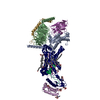 8f0kC 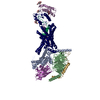 8f2aC 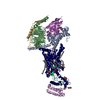 8f2bC M: map data used to model this data C: citing same article ( |
|---|---|
| Similar structure data | Similarity search - Function & homology  F&H Search F&H Search |
- Links
Links
- Assembly
Assembly
| Deposited unit | 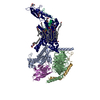
|
|---|---|
| 1 |
|
- Components
Components
-Guanine nucleotide-binding protein ... , 3 types, 3 molecules ABG
| #3: Protein | Mass: 45683.434 Da / Num. of mol.: 1 Mutation: S54N, G226A, E268A, N271K, K274D, R280K, T284D, I285T Source method: isolated from a genetically manipulated source Source: (gene. exp.)   Homo sapiens (human) / Gene: GNAS, GNAS1, GSP / Production host: Homo sapiens (human) / Gene: GNAS, GNAS1, GSP / Production host:   Trichoplusia ni (cabbage looper) / References: UniProt: P63092 Trichoplusia ni (cabbage looper) / References: UniProt: P63092 |
|---|---|
| #4: Protein | Mass: 38534.062 Da / Num. of mol.: 1 Source method: isolated from a genetically manipulated source Source: (gene. exp.)   Homo sapiens (human) / Gene: GNB1 / Production host: Homo sapiens (human) / Gene: GNB1 / Production host:   Trichoplusia ni (cabbage looper) / References: UniProt: P62873 Trichoplusia ni (cabbage looper) / References: UniProt: P62873 |
| #5: Protein | Mass: 7861.143 Da / Num. of mol.: 1 Source method: isolated from a genetically manipulated source Source: (gene. exp.)   Homo sapiens (human) / Gene: GNG2 / Production host: Homo sapiens (human) / Gene: GNG2 / Production host:   Trichoplusia ni (cabbage looper) / References: UniProt: P59768 Trichoplusia ni (cabbage looper) / References: UniProt: P59768 |
-Protein/peptide / Protein / Antibody / Sugars , 4 types, 5 molecules PRN

| #1: Protein/peptide | Mass: 3968.500 Da / Num. of mol.: 1 / Source method: obtained synthetically / Details: K21 lipid modification / Source: (synth.)   Homo sapiens (human) Homo sapiens (human) |
|---|---|
| #2: Protein |  / CT-R / CT-RMass: 58469.594 Da / Num. of mol.: 1 Source method: isolated from a genetically manipulated source Source: (gene. exp.)   Homo sapiens (human) / Gene: CALCR / Production host: Homo sapiens (human) / Gene: CALCR / Production host:   Trichoplusia ni (cabbage looper) / References: UniProt: P30988 Trichoplusia ni (cabbage looper) / References: UniProt: P30988 |
| #6: Antibody |  Single-domain antibody Single-domain antibodyMass: 15140.742 Da / Num. of mol.: 1 Source method: isolated from a genetically manipulated source Source: (gene. exp.)   Lama glama (llama) / Production host: Lama glama (llama) / Production host:   Trichoplusia ni (cabbage looper) Trichoplusia ni (cabbage looper) |
| #8: Sugar |  N-Acetylglucosamine N-Acetylglucosamine |
-Non-polymers , 6 types, 40 molecules 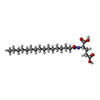



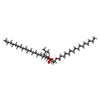






| #7: Chemical | ChemComp-D6M / | ||||||||
|---|---|---|---|---|---|---|---|---|---|
| #9: Chemical |  Phosphatidylethanolamine Phosphatidylethanolamine#10: Chemical | ChemComp-PLM /  Palmitic acid Palmitic acid#11: Chemical | #12: Chemical | ChemComp-P42 / ( | #13: Water | ChemComp-HOH / |  Water Water |
-Details
| Has ligand of interest | Y |
|---|
-Experimental details
-Experiment
| Experiment | Method:  ELECTRON MICROSCOPY ELECTRON MICROSCOPY |
|---|---|
| EM experiment | Aggregation state: PARTICLE / 3D reconstruction method:  single particle reconstruction single particle reconstruction |
- Sample preparation
Sample preparation
| Component | Name: calcitonin receptor in complex with Gs protein and San45 peptide Type: COMPLEX / Entity ID: #1-#6 / Source: MULTIPLE SOURCES |
|---|---|
| Source (natural) | Organism:   Homo sapiens (human) Homo sapiens (human) |
| Source (recombinant) | Organism:   Trichoplusia ni (cabbage looper) Trichoplusia ni (cabbage looper) |
| Buffer solution | pH: 7.4 |
| Specimen | Conc.: 4 mg/ml / Embedding applied: NO / Shadowing applied: NO / Staining applied : NO / Vitrification applied : NO / Vitrification applied : YES : YES |
Vitrification | Cryogen name: ETHANE |
- Electron microscopy imaging
Electron microscopy imaging
| Experimental equipment |  Model: Titan Krios / Image courtesy: FEI Company |
|---|---|
| Microscopy | Model: TFS KRIOS |
| Electron gun | Electron source : :  FIELD EMISSION GUN / Accelerating voltage: 300 kV / Illumination mode: FLOOD BEAM FIELD EMISSION GUN / Accelerating voltage: 300 kV / Illumination mode: FLOOD BEAM |
| Electron lens | Mode: BRIGHT FIELD Bright-field microscopy / Nominal defocus max: 1500 nm / Nominal defocus min: 200 nm Bright-field microscopy / Nominal defocus max: 1500 nm / Nominal defocus min: 200 nm |
| Image recording | Electron dose: 40.1 e/Å2 / Film or detector model: GATAN K3 BIOQUANTUM (6k x 4k) |
- Processing
Processing
| Software | Name: PHENIX / Version: 1.20_4459: / Classification: refinement | ||||||||||||||||||||||||
|---|---|---|---|---|---|---|---|---|---|---|---|---|---|---|---|---|---|---|---|---|---|---|---|---|---|
| EM software |
| ||||||||||||||||||||||||
CTF correction | Type: PHASE FLIPPING AND AMPLITUDE CORRECTION | ||||||||||||||||||||||||
3D reconstruction | Resolution: 2 Å / Resolution method: FSC 0.143 CUT-OFF / Num. of particles: 636000 / Symmetry type: POINT | ||||||||||||||||||||||||
| Atomic model building | B value: 44 / Protocol: AB INITIO MODEL / Space: REAL | ||||||||||||||||||||||||
| Refine LS restraints |
|
 Movie
Movie Controller
Controller





 PDBj
PDBj




























